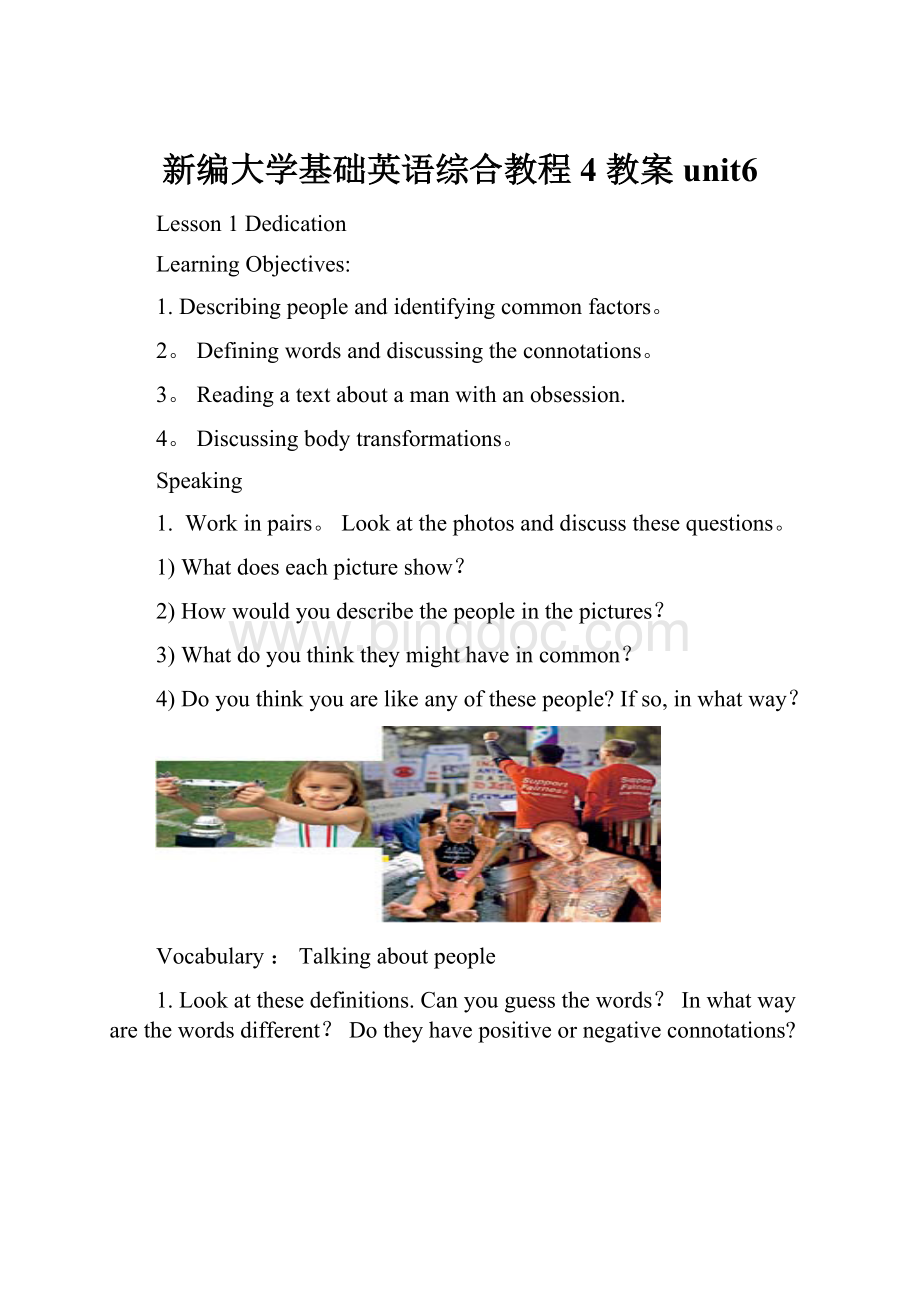新编大学基础英语综合教程4 教案unit6.docx
《新编大学基础英语综合教程4 教案unit6.docx》由会员分享,可在线阅读,更多相关《新编大学基础英语综合教程4 教案unit6.docx(25页珍藏版)》请在冰点文库上搜索。

新编大学基础英语综合教程4教案unit6
Lesson1Dedication
LearningObjectives:
1.Describingpeopleandidentifyingcommonfactors。
2。
Definingwordsanddiscussingtheconnotations。
3。
Readingatextaboutamanwithanobsession.
4。
Discussingbodytransformations。
Speaking
1.Workinpairs。
Lookatthephotosanddiscussthesequestions。
1)Whatdoeseachpictureshow?
2)Howwouldyoudescribethepeopleinthepictures?
3)Whatdoyouthinktheymighthaveincommon?
4)Doyouthinkyouarelikeanyofthesepeople?
Ifso,inwhatway?
Vocabulary:
Talkingaboutpeople
1.Lookatthesedefinitions.Canyouguessthewords?
Inwhatwayarethewordsdifferent?
Dotheyhavepositiveornegativeconnotations?
2。
Canyouthinkofanyothersimilarexamples?
traditional—old-fashioned—conventional
3。
Lookatthefollowingwords,whichareallsynonymsofdetermined。
Dothewordshavepositiveornegativeconnotations?
Dividethemintotwogroups,usingadictionarytohelpyou。
Positive:
resolute,unwavering,dedicated
Negative:
stubborn,wilful,obstinate,dogged
(single-minded,strong-willedandpersistentaredependentoncontext.)
4.Workinsmallgroupsandcompareyourideas。
Useoneofthewordstodescribesomeoneyou
know。
My11—year—olddaughterisreallyobstinate-nothingIsaycanpersuadehertoreadabook,shejustwatchesrubbishonTVallthetime。
5。
ReadtheshortprofilesbelowanddecidewhichwordinExercise3bestdescribestheperson。
Morethanonewordmaybeappropriate。
1)Apoliticianwhoalwaysgivesherfullsupporttoherpartyleader,evenwhenshedoesnotagreewithalltheparty’spoliciesunwavering
2)Anemployeewhoworksdayandnighttogetapromotion,eventhoughitwillprobablybegiventosomeoneelse.dogged/determined/persistent
3)Awomanwhohasrecoveredfromcancerthreetimesstrong-willed/resolute
4)Amanwhohasfailedhisdrivingtesttentimesandistotakehistestagainnextmonth.
determined/persistent
5)Achildwhorefusestowearbluetrouserstoday。
stubborn/wilful
6)Apresidentdefendinghisclub,whichrefusesmembershiptowomen.obstinate
7)Agirlwhodevotesallherfreetimetotennispracticeandhasnosociallifeasaresult。
single—minded
8)Asingle—parentfatherworking,studyingandbringinguptwochildren。
resolute/determined
Speaking&Reading:
Lexicalpreparation
(1)gobysth.:
tobeguidedbysth.;toformanopinionfromsth。
e。
g。
That'sagoodruletogoby。
2)losecount(ofsth。
):
toforgetthetotalofsth.beforeyouhavefinishedcountingit
e.g.Shehadlostcountofthenumberoftimesshe’dtoldhimtobecareful.
Speaking&Reading
1.Workinpairs.Makealistofthedifferentwaysthatpeopletypicallychoosetochangetheirbodies。
2。
YouaregoingtoreadanarticleaboutamancalledStalkingCat。
Whatchangesdoyouthinkhehasmadetohisbody?
3。
Readthearticleandcheckyourideas。
4。
Readthetextagainanddecideifthesestatementsaretrue(T)offalse(F)。
Iffalse,explainwhy.
(1)Plasticsurgeryisstillrelativelyunusual.F
Itisnowcommonplace
2)DennisAvnercan'trememberhowmanychangeshavebeenmadetohisbody。
T
3)ItisthoughtthatapsychologicalillnessmaybethecauseofStalkingCat’sbehaviour。
T
4)Becauseofthechangestohisbody,Catisinconstantpain。
F
Theprocedureshurtatthetimebutthereisnoongoingpain。
5)TheproceduresCathasundergonehavebeencarriedoutillegally.F
Hehastohavethesurgerycarriedoutbyabodymodificationartistbecauseitwouldbeillegalforamedicalprofessionaltoalterappearancetothisextent。
6)Catdoesnotsufferanypainduringtheoperations.F
Hecannothaveanaestheticbecauseonlyqualifieddoctorscanadministerit,sotheoperationsareverypainful.
7)Hedoesnotparticularlyenjoymakingthechangestohisbody。
T
8)Hewillprobablynotmakeanymorechangestohisbody。
F
Hisgoalistobecomeaperfectcrossbetweenacatandahuman,soitislikelyhewillcontinue。
5。
LookagainattheadjectivesinVocabulary,Exercise3。
WhichwouldyouusetodescribeStalkingCat?
6。
Workinpairs。
Discussthesequestions。
1)Thinkofsomeoneyouknowwhohasmadechangestohis/herbody。
Washe/shehappywiththeresults?
Why?
/Whynot?
2)Inwhatcircumstanceswouldyouconsidermakingchangestoyourbody?
3)Ifyoucouldtransformyourselfintoaperfectcrossbetweenahumanandananimal,whichanimalwouldyouchoose?
Why?
7.TranslatethefollowingsentencesintoEnglish。
1)如果可以依据以往的经验,这个航班会晚点的。
(goby)
Ifpastexperienceisanythingtogoby,theflightwillbelate.
2)失去配偶以后,人们必然要经历一段调整期。
(undergo)
Peopleinevitablyundergoaperiodofadjustmentafterthelossoftheirspouse。
3)这是首次向公众展出这幅画。
(display)
It'sthefirsttimethepaintinghasbeendisplayedtothepublic。
4)这条道路穿过沙漠伸向远方。
(stretch)
Theroadstretched(out)acrossthedesertintothedistance。
5)政府声称战争是必然的,这种说法显然是错误的。
(claim)
Thegovernment’sclaimthatthewarwasnecessarywasclearlymistaken。
Lesson2MindtheGap
LearningObjectives:
1。
Discussingphotosfromanexhibitionaboutdifferentcultures.
2。
Listeningtopeoplediscussingtheexhibitionandidentifyingtheiropinions。
3。
Pronunciation:
Howdoyoupronounceit?
4。
ZoomIn:
Contrastingusesofso。
5。
Readingane-mailfromafriendinadifferentculture。
6。
Discussingattitudesandopinions.
7。
Revisingandpractisingbeusedto/getusedto。
Speaking&Listening
1。
Lookatthepictures。
Theyarepartofaphotographicexhibitionbyvariousphotographers
aboutdifferentworldcultures。
Whatdoeseachphotoshow?
Wheredoyouthinkthephotosweretaken?
2。
Whatistheconnectionbetweenthepairsofphotos(a&b,c&d,etc。
)?
a&b:
Bothphotosshowtraditionaldancingwithagroupofpeople。
c&d:
Bothphotosshowfashion/clothes。
e&f:
Bothphotosdepictweddings.
g&h:
Bothphotosshowanimalsbeingridden。
3.Listentothreefriendstalkingabouttheexhibition。
Whichpairsofphotosdotheytalkabout?
Photographsa—b,e-f,g—h。
Dotheyagreeabouttheexhibition’smainpurpose?
No,thespeakersdon’tagree.
4。
Listenagainandcompletethesentences.
1)Thethreefriendswent。
。
.
toseeanexhibition.
2)Tanyanormallygetstired。
..
afterabouthalfanhourorso.
3)WhatimpressedPaulwas。
。
。
thefacttheyseemedtorefertoeachother—thattheydealtwithsimilarthemes。
4)Tanyabelievesthattheexhibitiontalksabout。
。
.
whatissimilarbetweenculturesratherthanwhatisdifferent。
5)Shealsothinksthatoursocietyis。
。
。
becomingmoreinternational。
6)Rashiddisagreeswithherinthat。
..
somedifferencesbetweenculturesareimpossibletoreconcile.
5。
Workinpairs。
Discussthesequestions.
(1)Whataspectsofyourcultureareyoumostproudof?
2)Doyouthinkweshouldemphasiseculturaldifferencesorsimilarities?
Why?
3)Whatkindofphotoswouldyouincludeinaphotographicexhibitionaboutyourculture?
Thinkaboutfood,music,architecture,art,customs,etc。
compareyourideaswithotherpairsanddecidewhichexhibitionsoundsmostinteresting.
I’dwanttoincludephotosofourmostimpressiveandiconicbuildings,likethe...
Pronunciation:
Howdoyoupronounceit?
StudentAsaysawordinphoneticscriptfromhis/hercard。
StudentBsaysawordfromtheright—handcolumnofhis/hercardthatgoeswiththewordStudentAsaid.
Forexample:
StudentA:
/a:
’tIstIk/
B:
aspirations
ThenitisB’sturn。
Writedownallofthecollocationsinthespace.
Zoomin:
So
1.Thefollowingsentencesallusethewordso.Matchthemtotheusesbelow.
1)Itwassogood。
2)Inormallygettiredafterabouthalfanhourorso。
3)They’retheresowecanseehowsimilarculturesare。
4)A:
Istheexhibitiononformuchlonger?
B:
Idon'tthinkso。
1)Itwassogood。
veryorextremely
2)Inormallygettiredafterabouthalfanhourorso。
sayingthatcertainfactsareimprecise
3)They'retheresowecanseehowsimilarculturesare.
expressingpurpose
4)A:
Istheexhibitiononformuchlonger?
B:
Idon’tthinkso。
referringbacktosomethingthathasbeensaid
2.Rewritethedialogueusingsowherepossible.
A:
IsJohncomingtotheexhibition?
B:
Yes,Ithinkthatheis.
A:
Great.When'shegoingtoarrive?
B:
Oh,about7o’clock.
A:
OK,good。
Idon'tknowhowmanypeoplearecomingtoday。
Wehadsuchalargenumberofpeopleyesterdaythatwehadtoclosethedoors.
B:
It'sdefinitelyoneofourmostsuccessfulexhibitions。
Howdidyoumanagetoattractthisnumberofpeople?
A:
Justadvertsinnewspapersandmagazines。
Youadvertisetoinformpeopleandthentheycome-it’sassimpleasthat.
3.Listenandcheck。
Reading&Speaking
1。
Workinpairs。
Youaregoingtoreadane-mailfromaBritishgirlwhohasrecentlymovedtoJapan。
WhataspectsofJapaneseculturedoyouthinkshementions?
2.Readthee—mailandcheckyourideas。
WhatisHeather’sattitudetotheculturalaspectsshementions?
3。
Findexamplesofthefollowinginthee-mail.
abbreviations•exclamations
colloquialmisspellings•informallinkingwords
grammaticalinaccuracies
4。
Workinpairs。
Findstatementsinthee—mailwhichtellyouthatHeather..。
1)hasstartedtoadapttolifeinJapan。
I’mgraduallygettingusedtomynewlifehere.
2)didn’tgetupearlybeforeshemovedtoJapan.
I’mnotusedtogettingupsoearly.
3)doesn’tlikeallJapanesefood。
Idon’tthinkI’mevergoingtogetusedtorawfish。
4)findsthepackaginginshopsconfusing.
don'talwaysknowwhatI’mbuying.
5)thinkstheJapaneseareinnovativeandimaginative.
whatwilltheycomeupwithnext,Iaskmyself?
6)believest